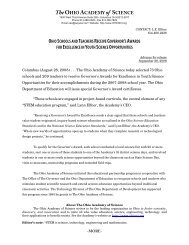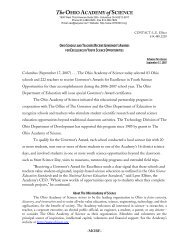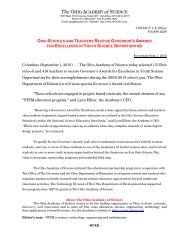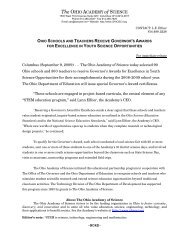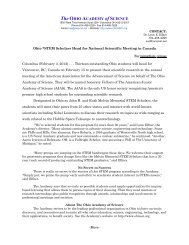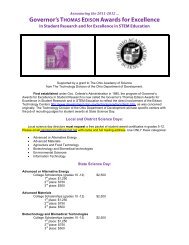The Ohio Journal of - The Ohio Academy of Science
The Ohio Journal of - The Ohio Academy of Science
The Ohio Journal of - The Ohio Academy of Science
Create successful ePaper yourself
Turn your PDF publications into a flip-book with our unique Google optimized e-Paper software.
A-44 <strong>The</strong> <strong>Ohio</strong> <strong>Journal</strong> <strong>of</strong> <strong>Science</strong><br />
Vol. 112(1)<br />
focal adhesions, is an oncogene. Its activity is regulated<br />
by tyrosine phosphorylation, and data show the tumor<br />
suppressor PTPRT dephosphorylates Paxillin at tyrosine<br />
88 (Y88). Since PTPRT suppresses colorectal cancer<br />
growth, Paxillin Y88 phosphorylation levels are higher in<br />
the tumor than in matched normal control tissue. To study<br />
the implications <strong>of</strong> this phosphorylation event, tyrosine<br />
88 was mutated to phenylalanine (Y88F), which cannot<br />
be phosphorylated. Accordingly, Y88F mutants were less<br />
tumorigenic, growing 20% more slowly than control cells<br />
in cell culture, displaying a 71% reduction <strong>of</strong> anchorage<br />
independent growth, and completely unable to form tumors<br />
in nude mice. However, why Paxillin PY88 is tumorgenic is<br />
still unknown. Since data show that mutants experience<br />
a 10-fold increase in abnormal cytokinetic events and<br />
occurrence <strong>of</strong> multinucleated cells (N = 214 parental cells,<br />
161 Y88F mutant cells), it is hypothesized that Paxillin<br />
PY88 has a role in the cell cycle. To test this hypothesis,<br />
HCT 116 colon cancer cells were arrested at various<br />
stages <strong>of</strong> the cell cycle to determine Paxillin PY88 levels.<br />
Three Western Blot results (n=1) show that Paxillin Y88<br />
phosphorylation occurs preferentially during mitosis.<br />
Western Blot results (n=1) also show that SRC kinase,<br />
an oncogene involved in mitosis, phosphorylates Paxillin<br />
PY88. Ultimately, understanding the role <strong>of</strong> Paxillin PY88<br />
in the cell cycle will better explain how PY88 is tumorigenic.<br />
Poster Board No. 040 SEROTONIN (5 HT) ANTAGONISTS EFFECT<br />
ON MDA - 2B31 BREAST CANCER CELL PROLIFERATION. Aarti<br />
Kumar 1 , kumarhome@yahoo.com, Dr. Laura Hernandez, 2 ,<br />
Ekta Yadav 2 1 William Mason High School, 2 University <strong>of</strong><br />
Cincinnati, 4637 Forest Ridge Drive, Mason, OH 45040<br />
Today, approximately 13.4% <strong>of</strong> women will develop<br />
breast cancer in their lifetime. Breast cancer is the<br />
uncontrolled cell growth <strong>of</strong> regular epithelial cells forming<br />
a malignant tumor through mutations or gene changes.<br />
Serotonin (5-HT) a signaling molecule also known as<br />
5-hydroxytryptophan is significant in the processes <strong>of</strong><br />
the mammary gland. Alteration in 5-HT production and<br />
tryptophan hydroxylase 1 (TPH1) enzyme activity leads<br />
to enhanced proliferation <strong>of</strong> breast cancer cells, which is<br />
opposite to what occurs normally. <strong>The</strong> project hypothesis<br />
was that if the 5HT receptors: 5HTR2B and 5HTR1D are<br />
blocked with receptor antagonist treatments; there will<br />
be less MDA-MB-231 cell proliferation and less Cyclin D1<br />
or mRNA gene expression. <strong>The</strong> methodology included cell<br />
culture <strong>of</strong> MDA-MB231 breast cancer cells, RNA isolation/<br />
cDNA synthesis, reverse transcription, MTT Assay, and<br />
Quantitative PCR (qPCR). Based on the MTT Assay, the<br />
5HTR1D antagonist proved to be more effective, decreasing<br />
proliferation <strong>of</strong> MDA-MB231 cells by more than 37% at<br />
a concentration <strong>of</strong> 100 µm. This analysis is statistically<br />
valid because the T-Test was 0.0007 (< 0.05). <strong>The</strong> 5HTR2B<br />
antagonist decreased Cyclin D1 gene expression from 1.1 to<br />
0.01 relative fold differences at an antagonist concentration<br />
<strong>of</strong> 100 µm. This indicates a 5HTR2B treatment effectively<br />
reduces the amount <strong>of</strong> Cyclin D1 gene expression. <strong>The</strong>se<br />
results support the hypothesis that Cyclin D1 expression<br />
decreases and breast cancer cell proliferation decreases<br />
after antagonist treatment.<br />
Poster Board No. 041 THE REGULATION OF METABOLIC<br />
INFLAMMATION BY MACROPHAGE KLF2. Yasemin Cobanoglu,<br />
ycobanoglu14@gmail.com, Wendy A. Goodman, Yoichi<br />
Takami, Nikunj Sharma, Ganapati H. Mahabaleshwar, G.<br />
Brandon Atkins, Mukesh K. Jain, Case Western Reserve<br />
University, Dept <strong>of</strong> Medicine, Cleveland OH 44106. (Hathaway<br />
Brown)<br />
Metabolic inflammation is associated with obesityinduced<br />
insulin resistance and enhanced susceptibility<br />
to atherosclerosis. Insulin resistance is a chronic<br />
inflammatory condition mediated by activated, tissueresident<br />
macrophages. <strong>The</strong>se macrophages accumulate<br />
in the liver, skeletal muscle, and adipose tissue, and<br />
secrete pro-inflammatory mediators to cause tissue<br />
dysfunction. Current studies explore the role <strong>of</strong> Kruppel-<br />
like Factor 2 (KLF2), a zinc-finger transcription factor, in<br />
modifying metabolic inflammation in vivo. <strong>The</strong> basis <strong>of</strong><br />
the hypothesis states that macrophage KLF2 regulates<br />
metabolic inflammation via repressive effects on NFκB.<br />
Mac-KLF2 ∆/∆ mice develop accelerated obesity when placed<br />
on a high-fat diet, gaining an average <strong>of</strong> 28.7g±0.8g during<br />
20 weeks <strong>of</strong> high-fat feeding, compared to control mice<br />
which gained an average <strong>of</strong> 22.1g±0.6g (p





